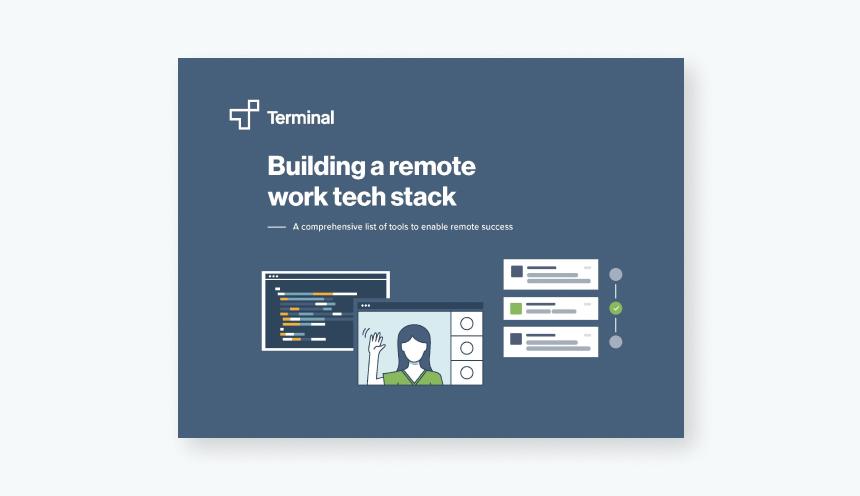
Remote how-to’s | Blog Post
10 Tips to Create Human Connection for your Remote Teams
Linzi Nield
Share this post
A strong remote team is critical for a modern company in the post-pandemic environment. It’s a major indicator that your organization is agile and will remain adaptive to the changes in the economy that are inevitable as shakeups continue.
However, one of the issues that has appeared with the advent of significant increases in remote work is a sense of lost connection in the workplace. A recent Terminal survey indicated that 35% of engineers say it’s harder to collaborate or feel part of the team when working remotely. Another 22% said that they felt lonely or isolated. This indicates that there are significant opportunities for remote team building that can help mitigate this effect.
Our Chief People Officer Jennifer Farris and Gitlab’s Head of Remote Darren Murph recently joined Range on a webinar about preparing for remote work. Take a look at the tips they shared on how to find a path to maintain a human connection through intentional actions that bring people together in the workplace.
How to Drive Better Connection With Your Remote Team:
1. Start From a Place of Trust.
It can be understandable to come from a place of discomfort when, at the start of the pandemic, remote working was relatively new. At this point, three years in, it should be a normal act to embrace the knowledge that your remote workers are maintaining their productivity.
Still, it can be challenging in mixed-team environments, where there is that uncertainty or discontinuity between the in-person team and the remote team. Preemptively approaching this barrier by remote team building and establishing connections with cross-team peers helps to establish trust from all perspectives; managers, remote workers, and office peers.
2. Set Measurable Objectives.
Trust can also be created by knowing your team is meeting their goals. “So, take a step back,” says Terminal Chief People Officer Jenn Farris, “and ensure the team can be successful in the way you’re set up – align on how we are going to hold everyone accountable, and communicate that information out.” That starts with documented goals and project plans that everyone can get behind. If these goals do not result in success, create a team-building exercise that empowers employees to speak their minds to gauge what works and what doesn’t.
3. Don’t Copy-and-Paste “in-person” into “remote.”
Murph says that this can be a common pitfall. “If you have an upcoming meeting…consider if that meeting is necessary? Is there a different way to approach this now that we’re working from home? Could this be done asynchronously? Are there new ways or new tools we can look at that would make our life more efficient?”
Recognize that the connection in the workplace is going to be different for remote or in-person teams. Also recognize that your approach to them will have to be distinct, but that there are also ways to cross the gap and build necessary rapport so that everyone feels a part of the same organization.
4. Consider a Virtual Off-site for the Team.
“We do this at Terminal,” says Farris, “we’re all in our preferred location and it’s all about human connection. It doesn’t have to be physical. It’s all about the emotional touch points you can create for people to make sure they feel included.”
It also allows people who are still in the office to connect more readily via remote team-building opportunities. If someone has worked with a remote worker for some time and feels the need to engage more directly, this space helps to facilitate that connection.
5. Embrace Asynchronous Communication.
While at first glance this may seem like the antithesis of connection, it can actually create a place for people to communicate and provide updates on projects no matter when in the day they do it. Gitlab takes this a step further, says Murph. “We have a bias toward asynch. Meetings are a last resort. We have a tool at the center of our workflows…that enables people to have whatever working hours suit them best.”
6. Create a Remote Culture Using Communication Tools such as Slack or Notion.
Document decisions, celebrate successes, and share company news digitally and consistently. Encourage employees across the spectrum to participate so that everyone has a strong sense of who is responsible for what, their specialization, and how they integrate with the overall organization.
These communication platforms are an excellent way to build connections in the workplace using non-traditional means and can be a great sign of flexibility and adaptability to potential candidates.
7. Onboard Remote Employees in Person, or Promote Travel Between Locations.
It’s recommended to bring remote hires to HQ at the start of their employment for a minimum of two weeks to help them build a strong relationship with the team when possible, but also recognize the possibility that new hires might be across the country or otherwise in a situation that isn’t practical. Onboarding can take the form of virtual Zoom meetings or other systems that incorporate both in-office staff and remote staff to build cross-collaboration.
8. Make sure There is Access to Leadership.
From blocking off office hours for remote teams to virtual Q&A sessions, company leaders need to be equally accessible to both internal and external employees. This helps to establish connections in the workplace and a sense of participation for both remote and in-office employees by giving them a direct line to the people at the top. It fosters trust and investment in the staff, which leads to happier employees and thus better productivity.
9. Consider Creating a Remote Team “Champion.”
At GitLab, Murph says having a remote function has been really critical to success. “It’s important to put the onus on someone driving this,” he says. “This lies somewhere between HR and operations. As you enter a remote space you’ll have a lot of communication gaps that pop up.”
The lead here acts as the go-between that can voice concerns from the remote employees to direct leadership and otherwise act as ambassador for their team. It’s critical for remote team building that they feel empowered and that they aren’t a “forgotten” component of a hybrid workplace.
10. Don’t Forget Mental Health.
Remember the person behind the screen. “The manager should be proactively checking in. If remote is new for your team, do more frequent quick check-ins that are without structure and just there to support people as individuals,” says Farris.
This establishes that you consider the remote employee to be valuable and builds a human connection in the workplace that is so critical for retention. In this era of rapid migration across positions and companies, building the kind of company culture that is supportive and conducive towards human connection is all the more important.


